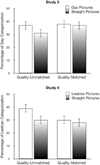Inferences About Sexual Orientation: The Roles of Stereotypes, Faces, and The Gaydar Myth
- PMID: 26219212
- PMCID: PMC4731319
- DOI: 10.1080/00224499.2015.1015714
Inferences About Sexual Orientation: The Roles of Stereotypes, Faces, and The Gaydar Myth
Abstract
In the present work, we investigated the pop cultural idea that people have a sixth sense, called "gaydar," to detect who is gay. We propose that "gaydar" is an alternate label for using stereotypes to infer orientation (e.g., inferring that fashionable men are gay). Another account, however, argues that people possess a facial perception process that enables them to identify sexual orientation from facial structure. We report five experiments testing these accounts. Participants made gay-or-straight judgments about fictional targets that were constructed using experimentally manipulated stereotypic cues and real gay/straight people's face cues. These studies revealed that orientation is not visible from the face-purportedly "face-based" gaydar arises from a third-variable confound. People do, however, readily infer orientation from stereotypic attributes (e.g., fashion, career). Furthermore, the folk concept of gaydar serves as a legitimizing myth: Compared to a control group, people stereotyped more often when led to believe in gaydar, whereas people stereotyped less when told gaydar is an alternate label for stereotyping. Discussion focuses on the implications of the gaydar myth and why, contrary to some prior claims, stereotyping is highly unlikely to result in accurate judgments about orientation.
Figures




Comment in
-
Evidence for the Absence of Stimulus Quality Differences in Tests of the Accuracy of Sexual Orientation Judgments: A Reply to Cox, Devine, Bischmann, and Hyde (2016).J Sex Res. 2017 Sep;54(7):813-819. doi: 10.1080/00224499.2016.1205547. Epub 2016 Aug 2. J Sex Res. 2017. PMID: 27485535
References
-
- Allport GW. The nature of prejudice. Reading, MA: Addison-Wesley; 1954.
-
- Ambady N, Hallahan M, Conner B. Accuracy of judgments of sexual orientation from thin slices of behavior. Journal of Personality and Social Psychology. 1999;77:538. - PubMed
-
- American Psychological Association. APA resolution on prejudice, stereotypes, and discrimination. 2006 Retrieved from http://www.apa.org/about/governance/council/policy/prejudice.pdf.
-
- Brebner JL, Martin D, Macrae CN. Dude looks like a lady: Exploring the malleability of person categorization. European Journal of Social Psychology. 2009;39:1109–1119.
-
- Bronski M, Pellegrini A, Amico M. ”You can tell just by looking” and 20 other myths about LGBT life and people. Boston: Beacon Press; 2013.
MeSH terms
Grants and funding
LinkOut - more resources
Full Text Sources
Other Literature Sources
